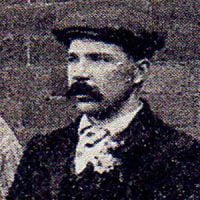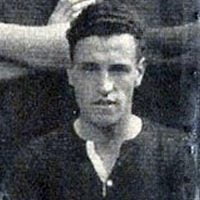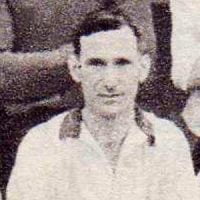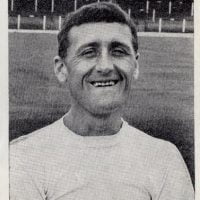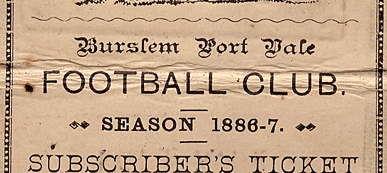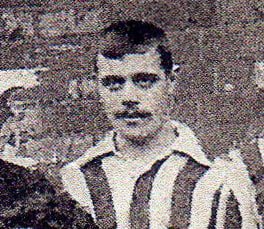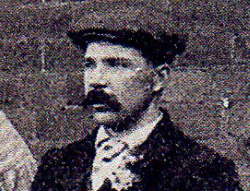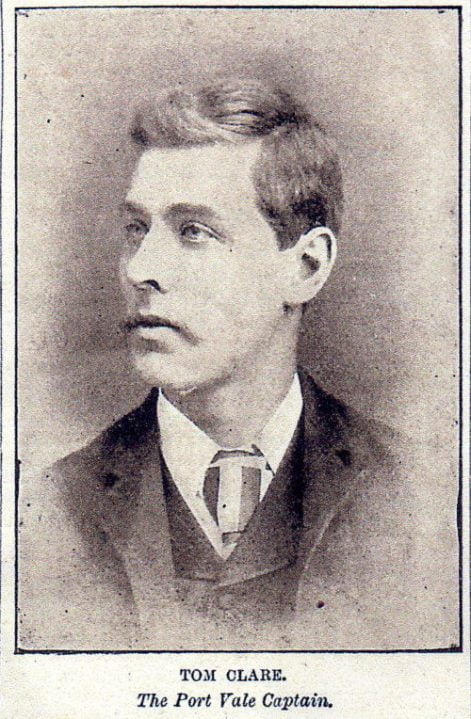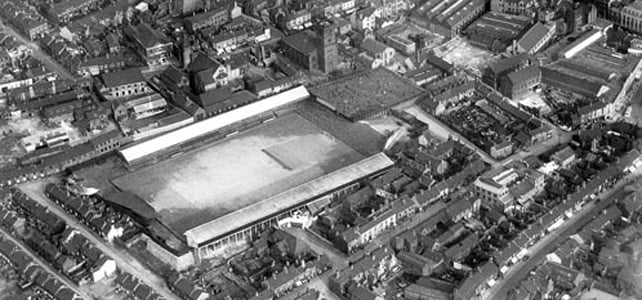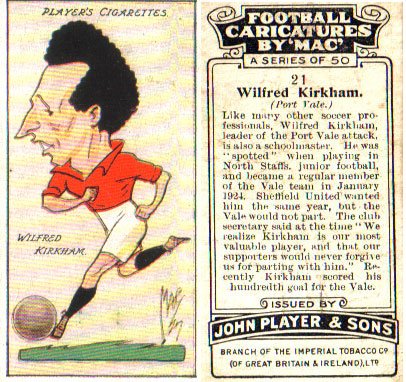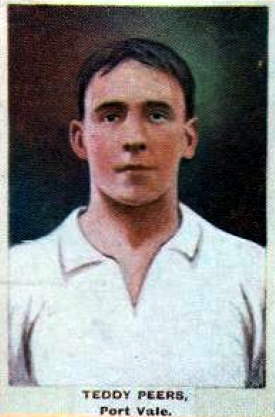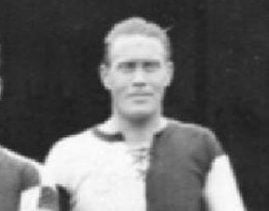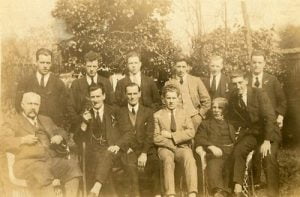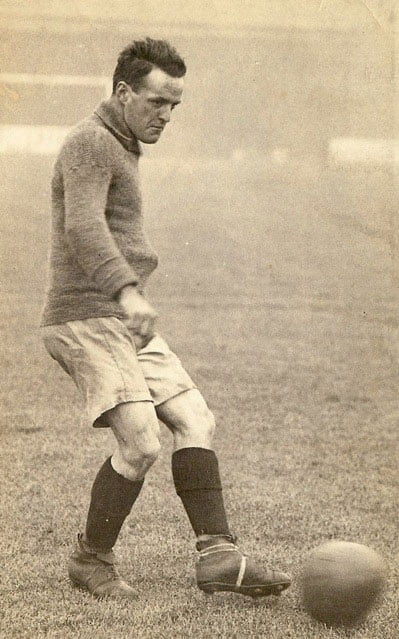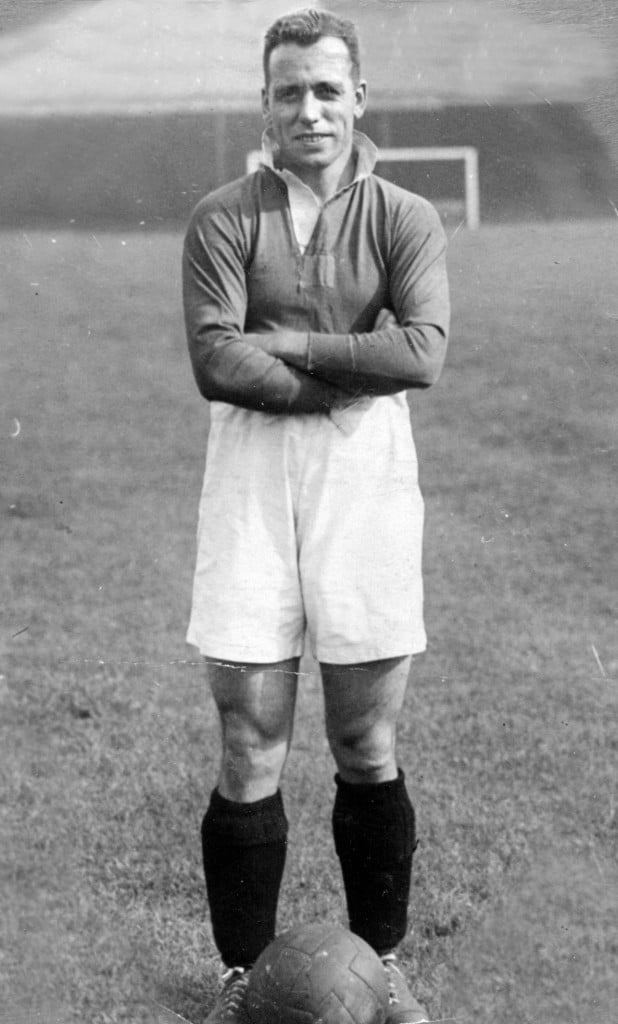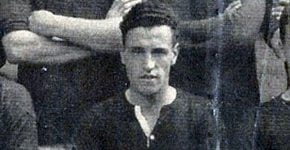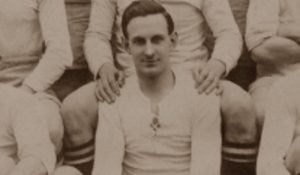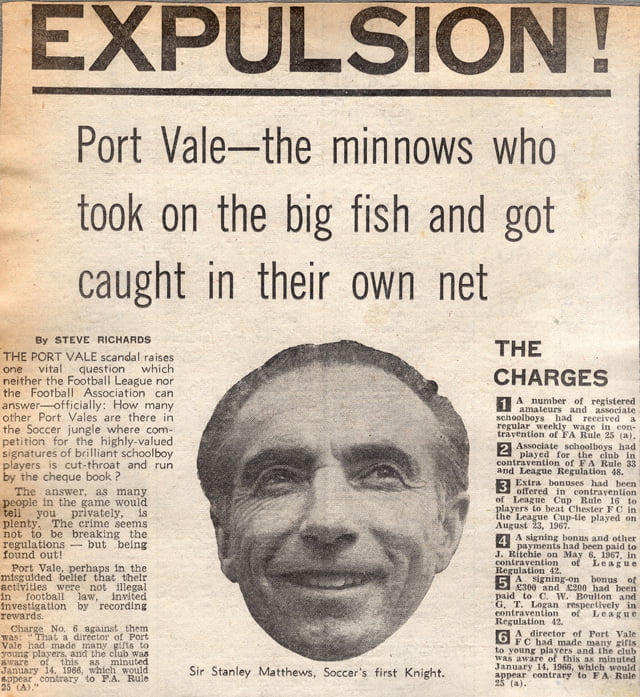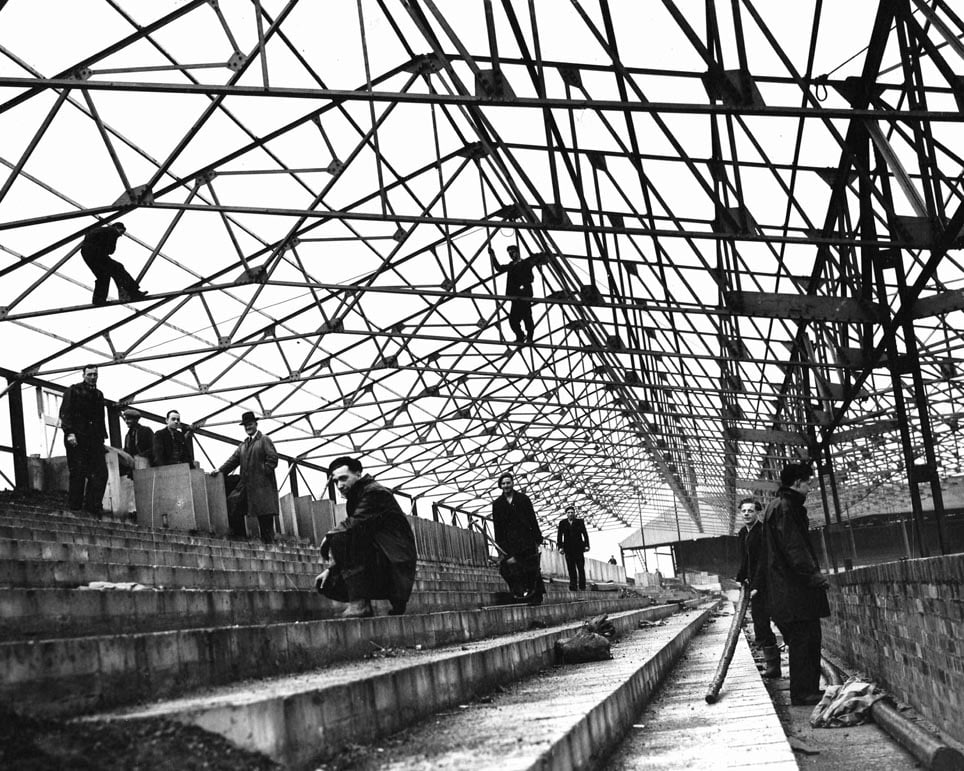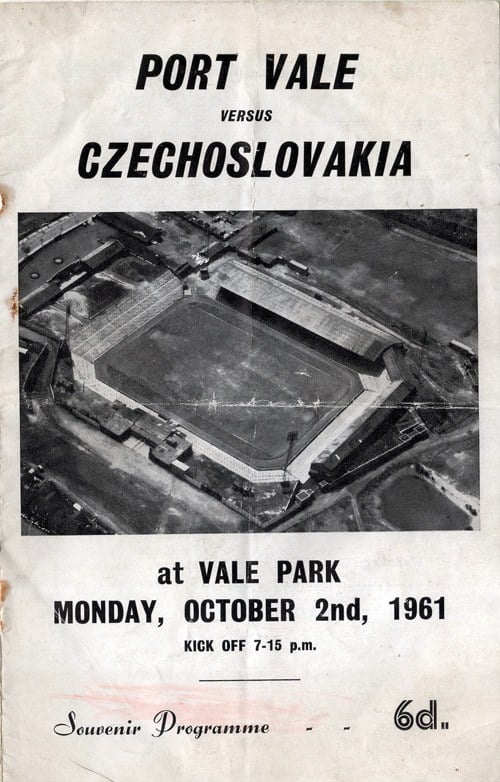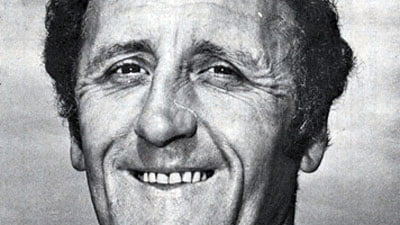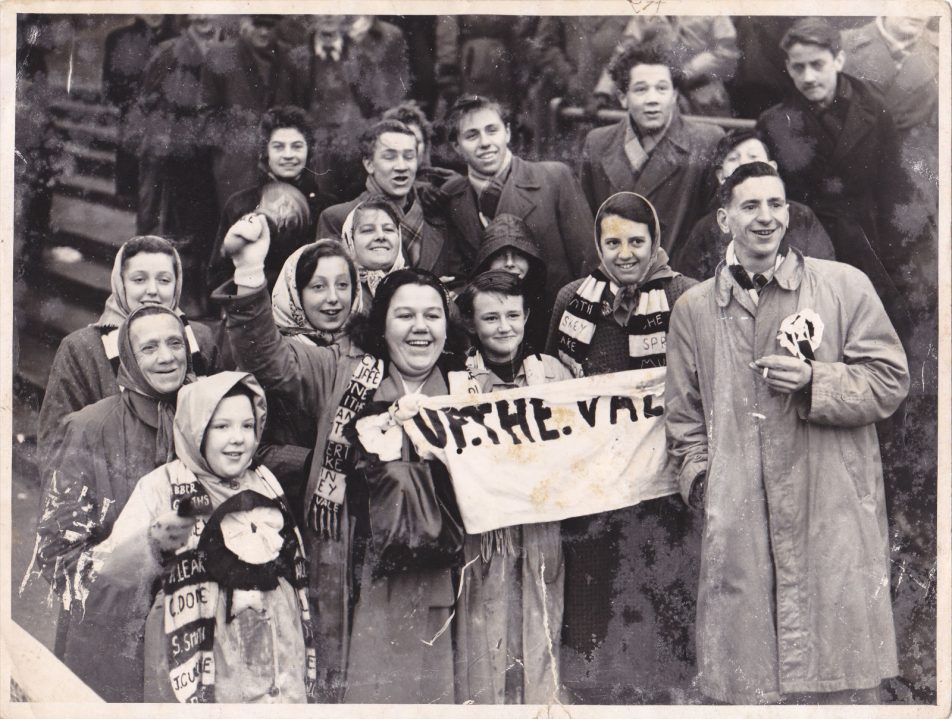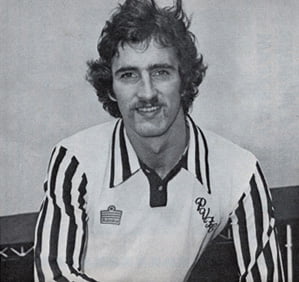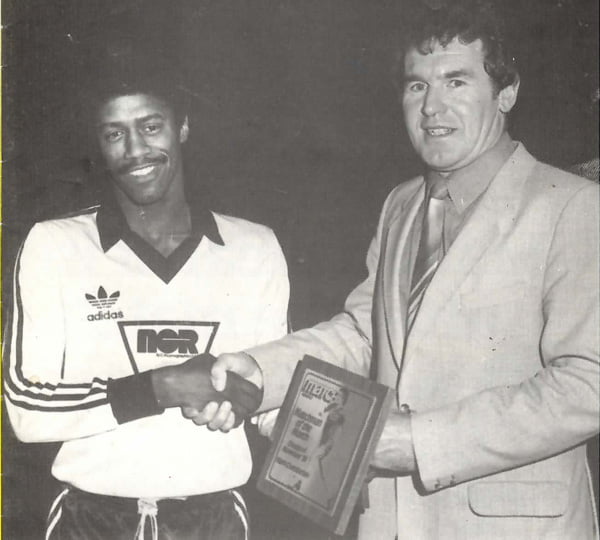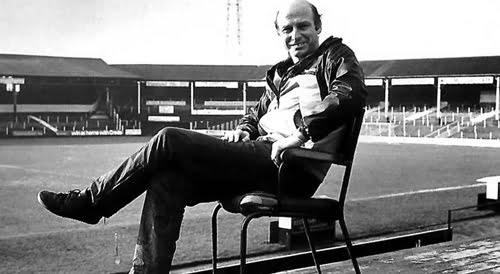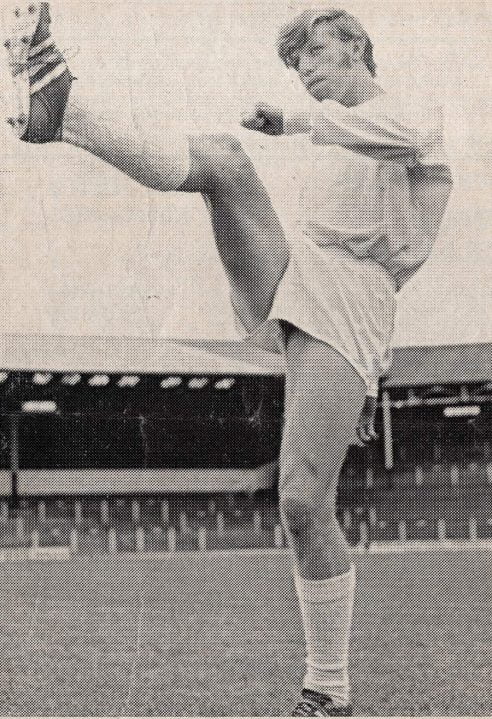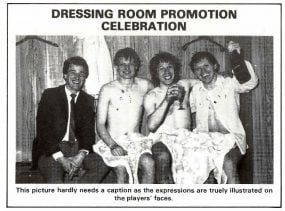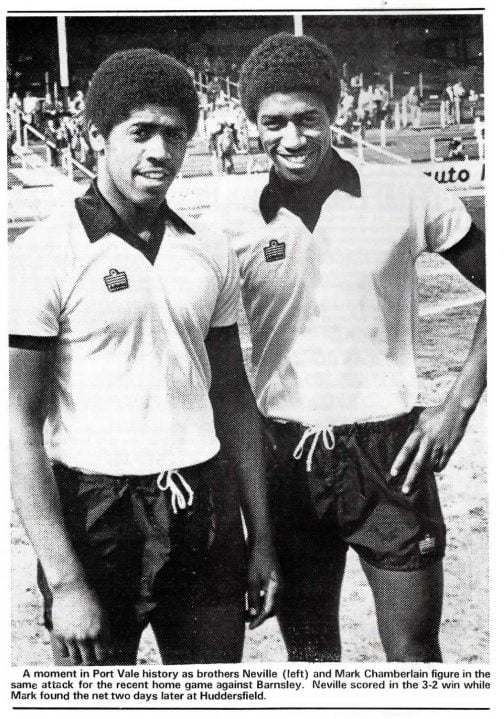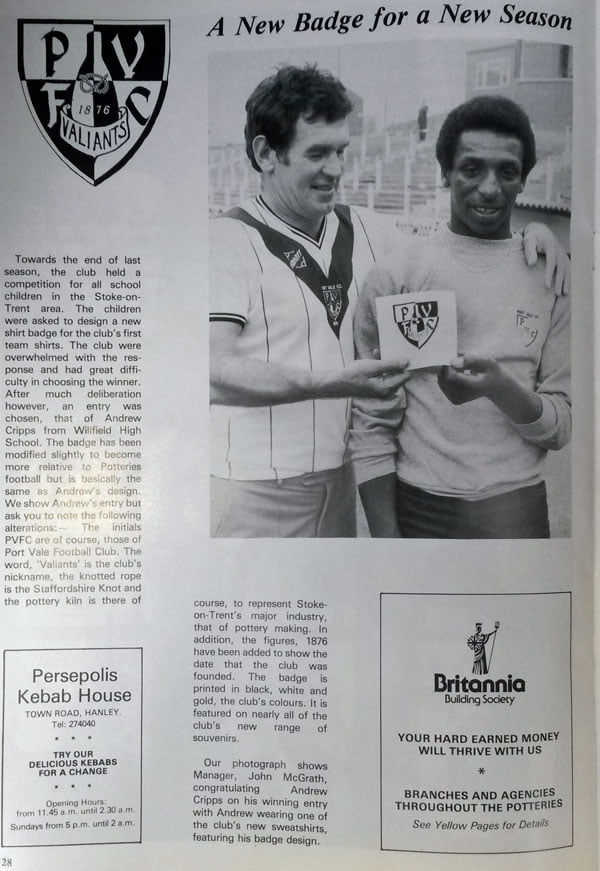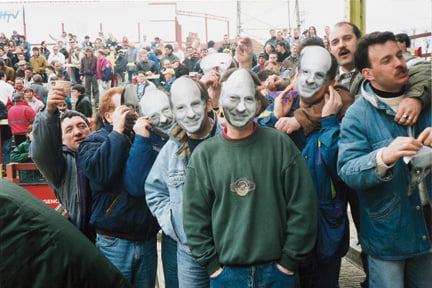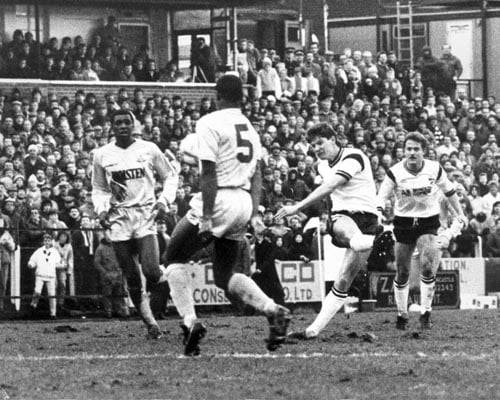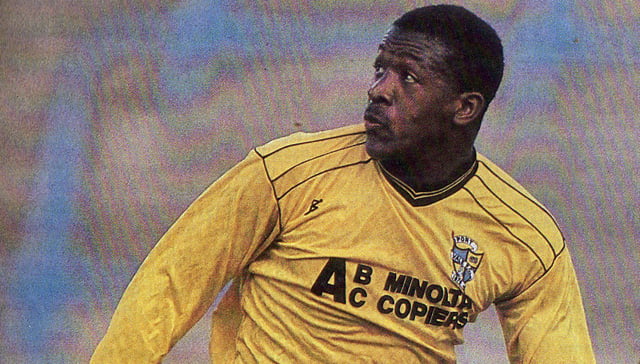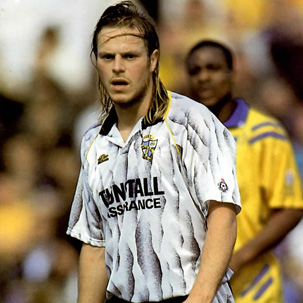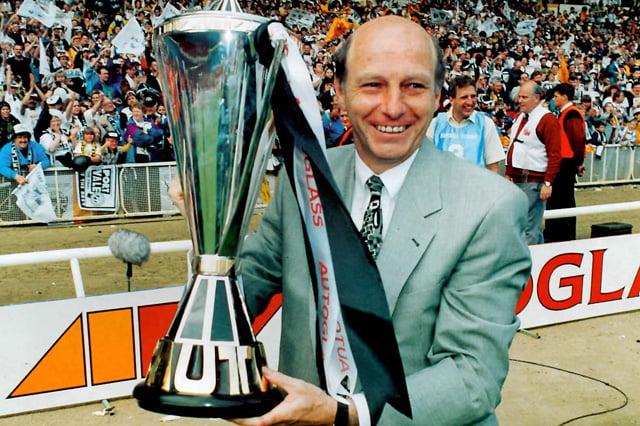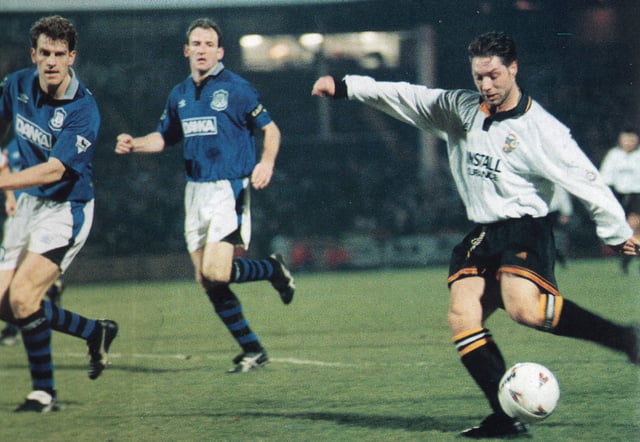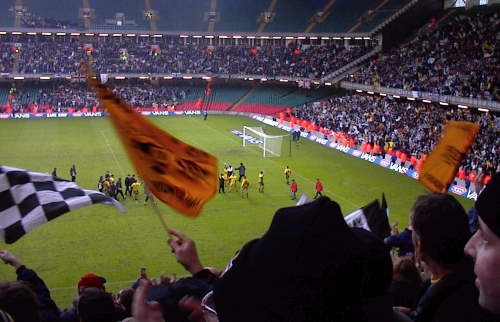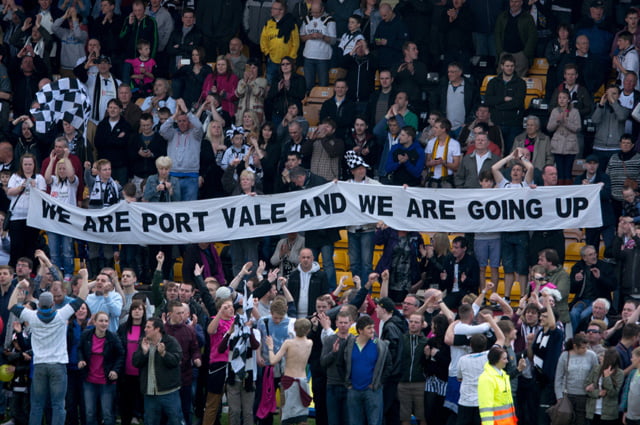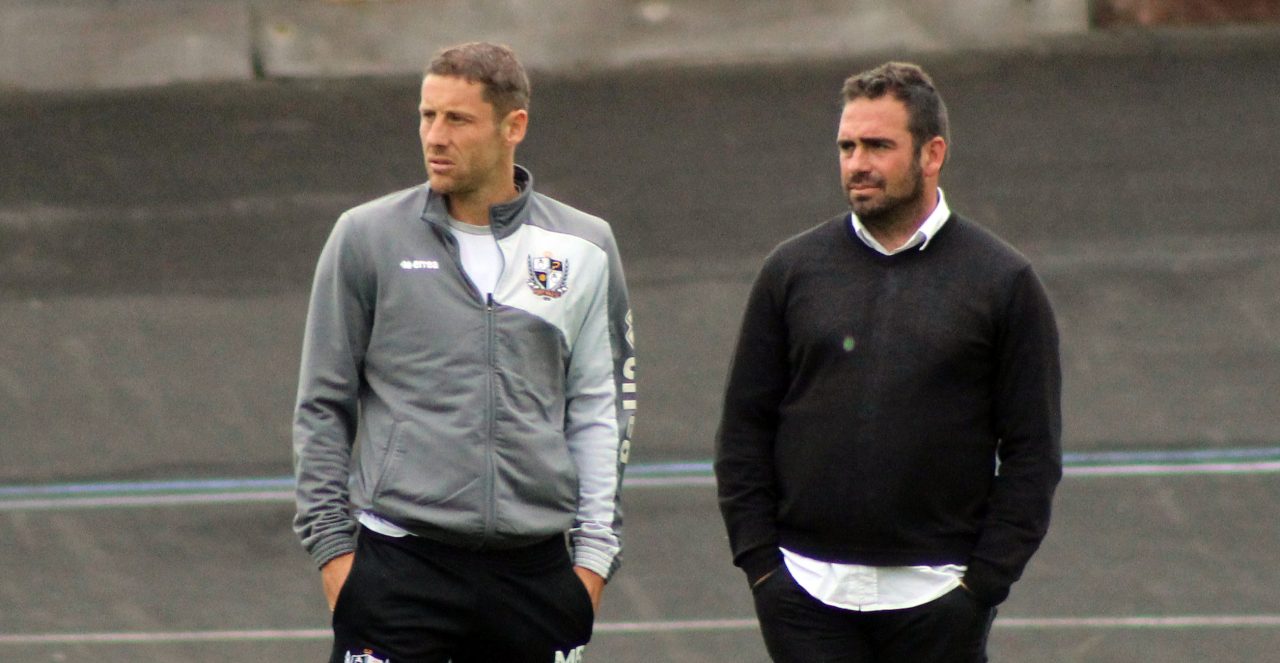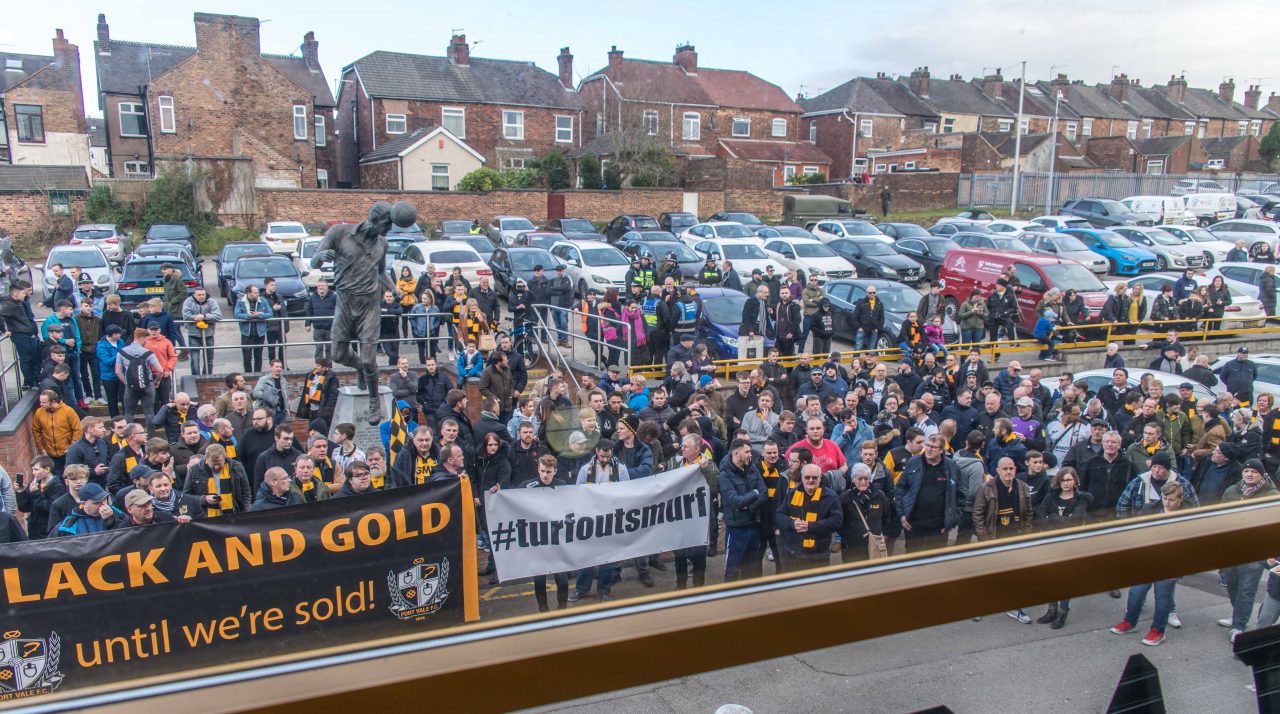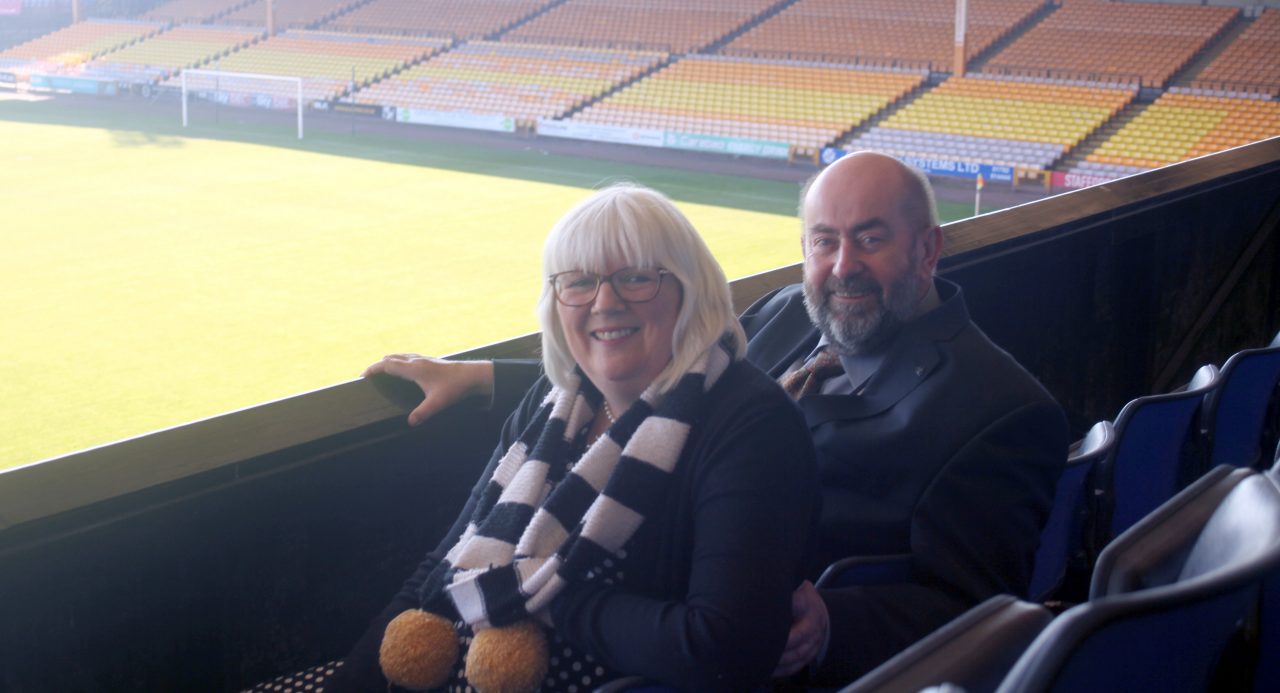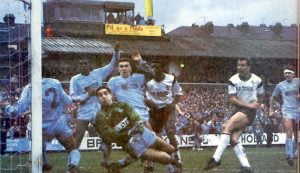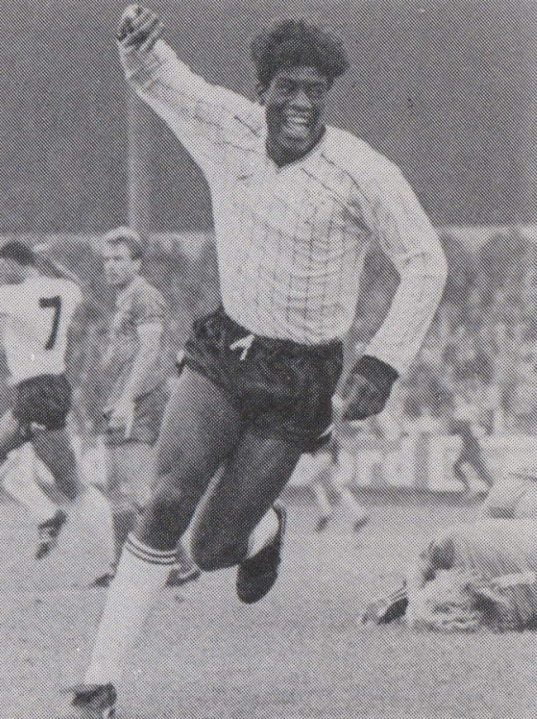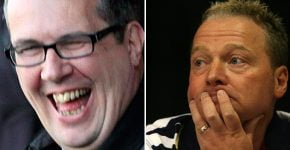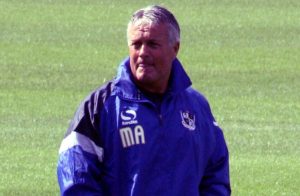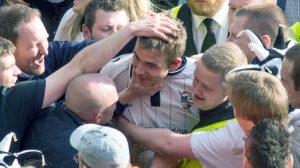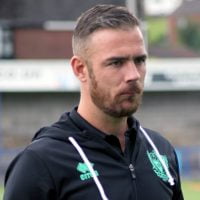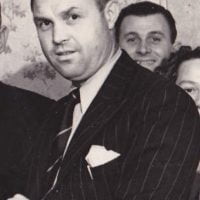
Port Vale history
Welcome to our comprehensive Port Vale history section. This page contains a naarative of the club history along with panels containing links to related content (much of it exclusive) which is available on this website. To begin, select an era from the options below:
1876 to 1912
1913 to 1949
1950 to 1968
1969 to 1987
1988 to 2019
1876 to 1912 Port Vale History Part One: foundation and the possible origins of that name
Summary
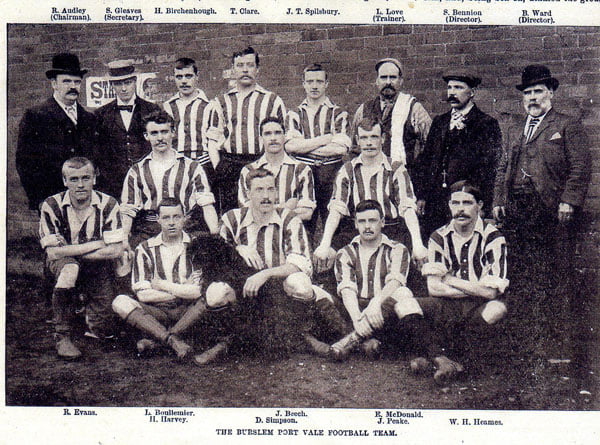
The club name
The club’s unique name of Port Vale has attracted much interest and continued debate to this day. Here is a selection of the most popular theories and it could be that the actual formation is due to one or several of these:
Possible origins of the club name
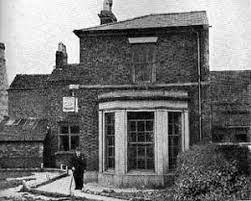
- A Port Vale cricket club was in existence in 1874, which lent its name to the football club.
- Port Vale was formed during a meeting at the Port Vale House, from where the club took its name.
- The players who founded the club lived near such places as: Port Vale Wharf, Port Vale Street, Port Vale Corn Mills and Port Vale House.
- Nearby Porthill Victoria (for whom founder players John and Enoch Hood may have previously played) played upon a hill, therefore the team of the valley may have chosen Port Vale as “a rather natural choice” of team name.
- The name came from a shortening of “Longport Vale.”
- Port Vale was formed from a merger of Wolstanton, Middleport and Burslem St. Paul’s.
- Port Vale was originally a brickworks team. This theory is based on the existence of bricks with “Burslem Port Vale” and “Port Vale” marked upon them.
Most probably origin of the club name
Historian Jeff Kent has researched the history of the club in some depth and he has indicated that the club was probably formed in 1879 as an offshoot of Porthill Victoria FC and took its name from the valley of canal ports where the team played
First fixture
Enoch Hood – one of the founding members of the club – was the captain for the club’s first competitive fixture versus Stoke City in 1879.
Vale started to enjoy some success in the non-league field – particularly in the FA Cup – but without a permanent base, the club moved grounds several times before settling at the Cobridge Stadium which was to remain their home from 1886 until 1913.
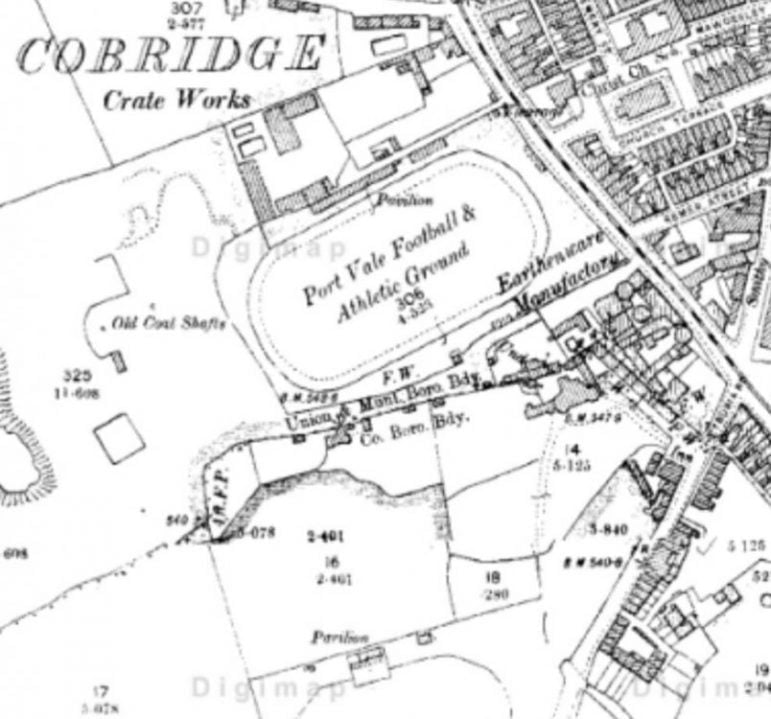
The club had by this time adopted the name Burslem Port Vale and were elected to the Football League in 1891 as members of Division Two.
First League campaign
The eve of Vale’s first campaign in League Division Two was blighted by the death of star player Frank McGinnis at just 23 years of age. The Staffordshire Sentinel newspaper’s obituary described him as “one of the finest centre-forwards in the country.”
Vale lost 5-1 away at Small Heath in their first match with Wallace Bliss securing his place in Port Vale history by scoring the club’s first-ever league goal. Vale went on to finish the campaign eleventh out of twelve sides.
The next eighteen years were a continuous struggle. The club regularly finished at the bottom of the league and finances were very tight.
In 1907, the club was finally wound up and taken over by Cobridge Church – a local Staffordshire non-league side. The club was reformed under the leadership of fan and former chairman Sam Bennion and in 1912, after a 27 year stay at the Cobridge Stadium, Port Vale moved into a new home.
Related features and media
A unique Port Vale artefact
This season ticket was given to the onevalefan website at our Vale Vaults exhibition. It was examined by a club historian who declared it to be the second-oldest known item of Port Vale memorabilia. You can read more about it through this link
The club’s foundation date
We were kindly given a copy of the Golden Penny magazine with an early feature on Port Vale. Interestingly, it disputes the official formation date of 1876. Read more here
Record defeat
We were given a clipping about Port Vale’s club record defeat. It occurred in 1892 as the side conceded ten goals to Sheffield United. You can see the clipping here
An astonishing run
On the flipside, here’s a special report we ran on Port Vale’s remarkable start to the 1893-1894 season. You can find out more about it here
The first giantkilling
Port Vale have had many famous cup upsets but do any of them really match this win over the then near invicible Sheffield Utd. Read more about this upset
An incredible character
One of our favourite personalities at Port Vale is Sam Bennion. He may not be that well-known to current Port Vale fans but he holds the unique distinction of being fan, official, player, manager, director, chairman and club saviour. Read our article on him here
Other personalities
Our cult heroes feature has a few articles on memorable figures. Click on the links to read more:
1913 to 1949 Port Vale History Part Two: the move to the Old Recreation Ground and emergence of Wilf Kirkham.
Summary
The Old Recreation Ground
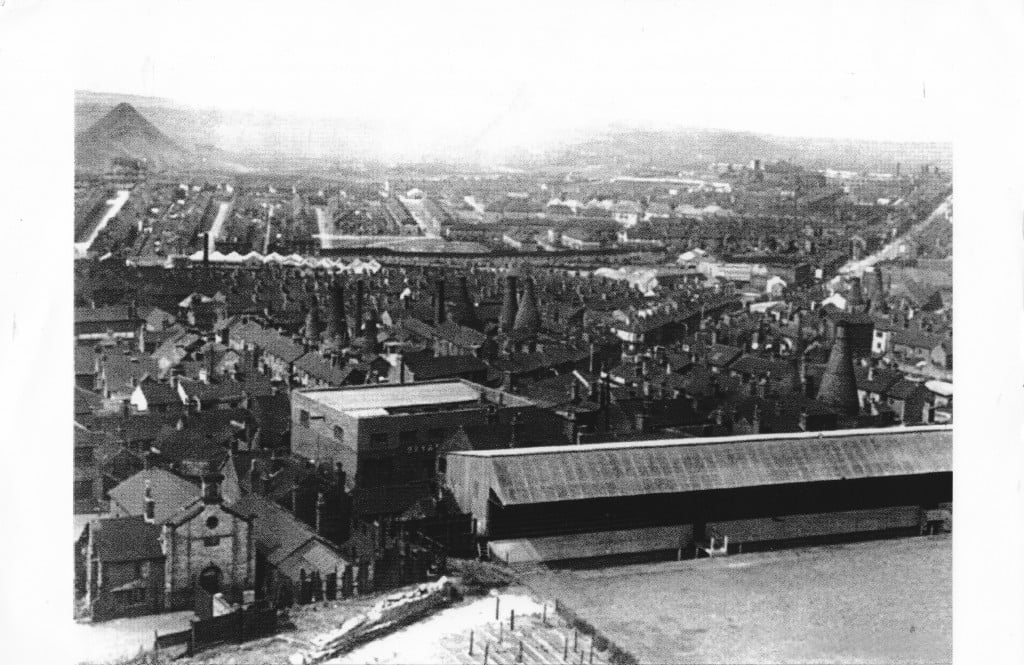
In 1913, Port Vale gained permission from Stoke-on-Trent council to develop the Kent Street Recreation ground in Hanley. The new ground was re-named the Old Recreation Ground and had room for 30,000 fans.
In 1915, Vale were granted temporary re-election to the Football League as World War One continued to reek havoc on the footballing world.
One of Vale’s guest players during the war period was legendary Billy Meredith of Manchester City. Vale also signed several Wolves players during the war as the West Midlands side stopped playing during the wartime period.
Back in the League
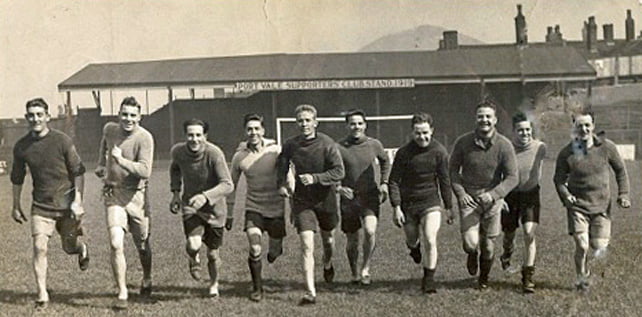
After the war, Vale returned to the Central League. But in 1919, league side Leeds City were thrown out due to illegal payments and Port Vale were dramatically re-elected back into the Football League to take over their fixtures.
Ironically, Vale themselves were then found guilty of illegal payments in 1921 but it was on a much smaller scale and the club escaped with a £100 fine.
On the 27th October 1923, a locally-born 20 year old reserve striker called Wilf Kirkham made his debut. He was to become the club’s all-time record scorer during a nine year stay with the Vale.
In October 1925, the now free-scoring Wilf Kirkham was chosen to represent the Football League in an exhibition match. But in April 1926 there was an announcement that was to rock the club to the very foundations.
Merger threats
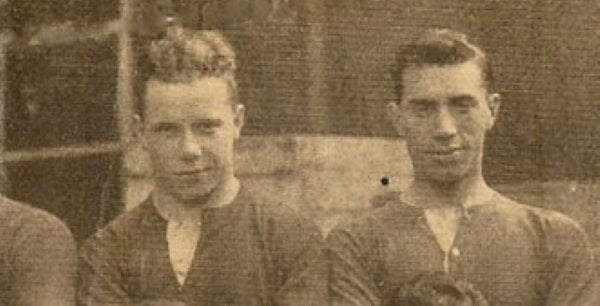
It was announced that Club Directors had agreed in principle to a proposal from their local rivals. Vale were to merge with Stoke City.
However, Vale fans vowed to fight any merger with their rivals. Supporters’ groups indicated that even if such a merger took place, a new Port Vale football club would remain, independent of their local rivals. This dramatic action was not needed as Stoke Directors eventually decided against the scheme.
In 1927, Vale were concerned with the Old Rec’s lack of space and a move back to a re-vamped 50,000 capacity Cobridge Stadium was suggested. However, the council still held first refusal on the stadium’s lease and refused to offer a reasonable price for the Old Rec.
The plan collapsed.
In 1927, highly rated fullback Jimmy Oakes had a trial with England but in May 1929 there was another body blow for Vale’s patient supporters when Wilf Kirkham was controversially sold to Stoke City. He had been top scorer for five consecutive seasons.
First promotion

However, the loss of Kirkham didn’t stop the club celebrating a key moment in Port Vale history in 1930 as the club claimed their first-ever promotion, finishing as champions of the Third Division North. 103 goals had been scored with Strikers Sam Jennings and Albert Pyengar scoring 47 goals between them.
Two thousand fans appeared at the Town Hall to begin the celebrations and were greeted by former player Wilf Kirkham who could not resist attending.
In 1930-1 Vale went on to reach their highest-ever placing of fifth in Division Two. The gates reached an average of 10,870 and Vale celebrated by taking a brief tour of Holland.
A new concrete stand was build on Bryan Street during the summer that could hold 4,800 supporters. It was announced that it was “as big as any stand in the football world.”
Kirkham returns
In 1932 Wilf Kirkham returned from his spell at Stoke City and fellow striker Stewart Littlewood was selected for the FA representative team.
Kirkham’s return did not last long as he retired from the game in 1933 to take up a full-time teaching position and following his departure, Vale were promptly relegated back to Division 3 in 1936 after the side shipped 106 goals that season.
In 1939, fixtures were abandoned for the Second World War while arrangements were being formulated to build a new Port Vale ground in Burslem.
In 1945, 16 year old striker Ronnie Allen made his debut. He was to later become an England International.
The Old Rec – a source of fond memories for many older supporters was eventually redeveloped as a shopping centre.
Related features and media
A first for the club
Goalkeeper Teddy Peers became the club’s first-ever International in 1922, you can read more about this fascinating character here
A promotion first
In 1929-30 the club achieved a memorable promotion despite the tragic death of manager Joe Schofield midway through the campaign. You can read about the side’s amazing start here, the tragic loss of Joe Schofield here, and about star striker Sam Jennings here (he is pictured above)
The Valiants emerge
How did the club obtain its nickname? We explained how in our article about the origins. It all began with a campaign from the club chairman… Read more here
Kirkham on camera
We also managed to get some footage of legendary goalscorer Wilf Kirkham in action. See it through the clip above:
The era captured on film
We were kindly given some cracking photos of the 1920s by Leigh Briscoe, a relative of long-serving Vale player Billy Briscoe. You can see them here
Bob Connelly and his medal
We were also provided with some photos from the family of former player Bob Connelly which are here and this website also obtained his Staffordshire Senior Cup winners’ medal which we donated to the club.
Five of the best…
We’ve ran a number of articles on some of the notable players from this era including:
So many personalities
We’ve also profiled several of the players from this era:
1950 to 1968 Port Vale History Part Three: The move to Vale Park, the cup run of the famed ‘Steele Curtain’ side and the controversy over league expulsion.
Summary
A new ground
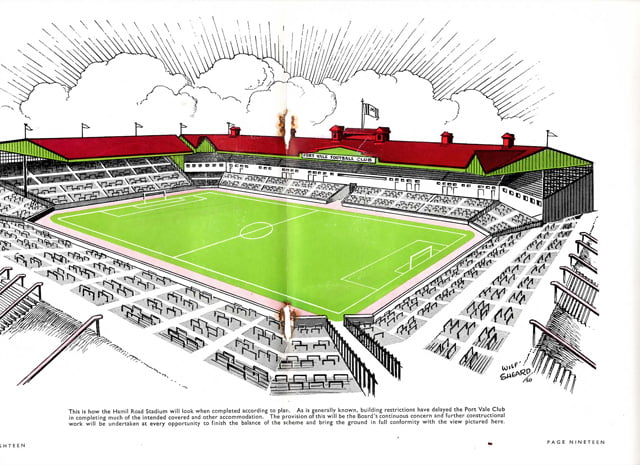
In 1944, following problems with the City Council over the lease of the Old Rec, Vale arranged to sell their current ground and a new thirteen and a half acre site was purchased near to Burslem station.
A 70,000 capacity was ambitiously planned with parking for 1,000 cars along with a new entrance to the ground from the train station.
In 1946, the construction of the new ground was financed by the sale of part of the Burslem site to a colliery. Although this provided the funds to develop the new ground, the mine workings were to prove a constant and costly hazard in later redevelopments.
But 1948, the cost of the new ground were rising steeply. Work had already cost £13,000 and at £100 the pitch was “the most expensive ever laid in Britain”.
However, with the lease on the Old Rec running out, Vale pressed ahead and arranged to complete the new ground in stages. The two terraces and Bycars end would be concentrated on for the time being and the main stand on Lorne St would be delayed until 1950. A reduced initial capacity of 40,000 was announced for the newly named ‘Vale Park.’
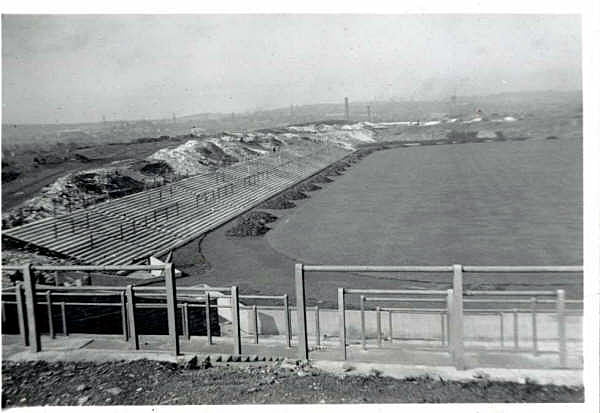
The ground opened in time for the 1950-1 season. It had cost £50,000, had a capacity of 40,000 and a vast playing surface of 115 by 83 yards. After finally getting approval, the old Swan Passage stand from the Old Rec was assembled on the Bycars End to provide some much needed cover.
A crowd of 32,042 turned up for the first match and saw Walter Aveyard score the first goal at the new ground in a 1-0 win over Newport County. The only disappointment was the club record sale of star striker Ronnie Allen to West Bromwich Albion – to help ease increasingly stretched club finances.
Start of the Steele era
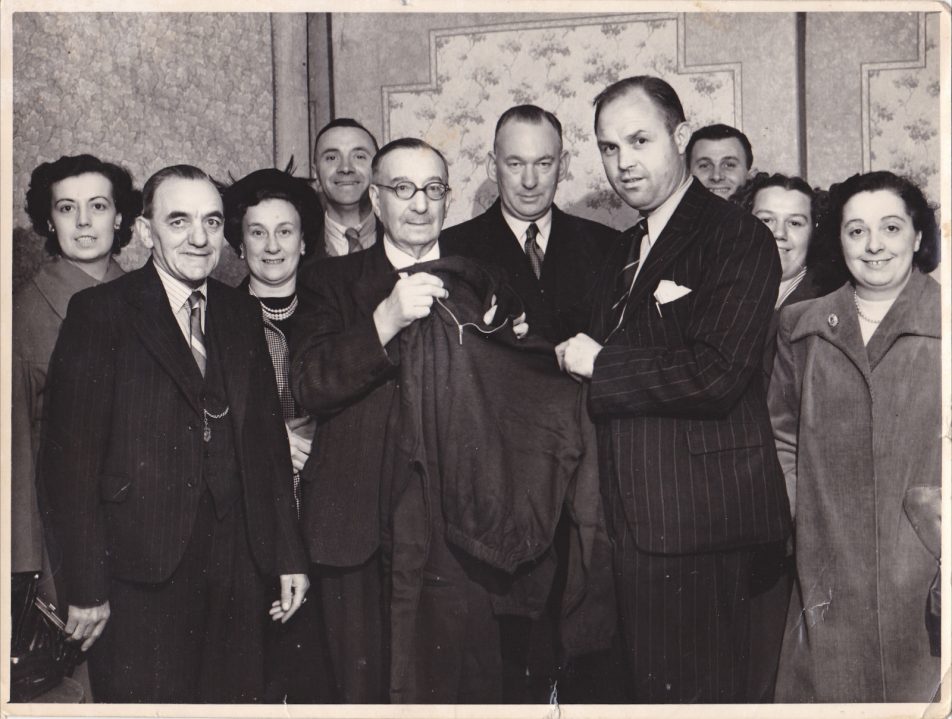
In 1952, Freddie Steele joined Port Vale, initially as player-manager. Steele was an experienced England International and by 1954 he had formed a side consisting of eight locally-born players – of which none had cost more than a £10 signing on fee.
Four of the defenders in the side were locally born. Youngsters Roy Sproson, Reg Potts and Stan Turner were complimented perfectly by the experience of club captain Tom Cheadle and goalkeeper Ray King.
The new-look defence soon became a formidable unit and began to be referred to as the Iron (or Steele) Curtain for their ability to snuff out opposing forwards.
The side became unstoppable in the Third Division North. They opened with 43 points (out of a possible 50) from their first 25 league games and a mere eight goals were conceded by that famed defence.
Cup Kings
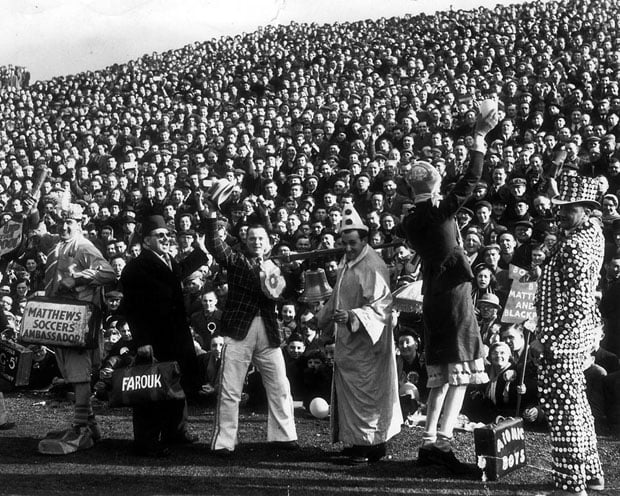
Vale also rose to the occasion in the FA Cup. In the fourth round Vale put out First Division Cardiff City and were subsequently drawn against current cup holders Blackpool. Their star-packed first division squad contained six current Internationals and local hero Stanley Matthews.
Vale conceded just one goal in fifteen home games up as the big match approached. Typically, as one of Vale’s most important matches got closer and closer, the Burslem weather got steadily worse and reports claim that it rained solidly for a week before the match. The Vale Park pitch was a quagmire, but interest still remained high as thousands queued for tickets.
The big game kicked-off and in the 14th minute Dickie Cunliffe broke clear on the left only for his shot was deflected out for a corner. From Cunliffe’s kick, inside-forward Albert Leake rose to head the ball in. Vale made it 2-0 in the 26th minute as Cunliffe started the move and laid the ball to centre forward Basil Haywood, whose low cross was driven into the net by Leake.
Blackpool never got back into the game as Vale cleverly forced Matthews away from the drier edges of the pitch and into the muddy middle where he met a massed defence. Late on Ken Griffiths hit the post for Vale, while Basil Haywood was fouled in the box only for no penalty to be given.
The national press praised “Vale’s hard-working display” and called it a “triumph of teamwork.”
Vale were drawn against fellow Division Three side Leyton Orient in the sixth round. Eight special trains took 8,000 Vale fans to the match and they saw Vale triumph 1-0 with Albert Leake scoring the only goal. Vale were through to the FA Cup semi-final for the first time in their history. They were drawn against First Division giants West Bromwich Albion who contained former Vale striker Ronnie Allen in their team.
As excitement reached fever-pitch, 40,000 people turned up for a Vale reserve match versus Mossley in order to queue for Semi-Final tickets.

A hundred coaches and fourteen special trains carried the army of Vale supporters to Villa Park on 27th March. A crowd of over 68,000 saw Vale sensationally take the lead in the 40th minute through Albert Leake.
Defender Roy Sproson commented “At half-time we thought the game was over.” However, in the second half the Baggies rallied and a 68th minute equaliser was fashioned from a long ball through the Vale’s Iron Curtain defence.
Then disaster occured as captain Tom Cheadle tackled Albion forward Lee on the edge of a box. A disputed penalty was awarded and former Vale star Ronnie Allen scored an unlikely winner. Roy Sproson claimed that Lee had handled the ball and taken three steps before falling and the West Brom keeper stated afterwards “You had all the bad luck”. The Valiant Vale were out of the FA Cup after a memorable run.
Following the disappointment of the semi-final exit, the team could now concentrate on promotion. Vale returned to league football but their cup run had left a daunting run of twelve fixtures in thirty days.
However, the Iron Curtain settled into their old ruthless routine. Vale secured promotion with a win over Bradford City in April and a record 7-0 rout of Stockport followed as Vale swept to the Third Division Championship.
The team had won promotion with 69 points, eleven points clear of second placed Barnsley. The “Iron Curtain” defence (with the same five players virtually ever-present) had conceded just 21 goals all season with just five coming at undefeated Vale Park. This was a league defensive record which stood for thirty years.
Only three games had been lost all season while in attack 74 goals had been scored. Basil Haywood topped the scoring charts with 25 goals while Albert Leake had 20. The “Iron Curtain” side were by now the stuff of Vale legend.
End of an era

The season after the unprecedented success of the “Iron Curtain” promotion, Vale constructed a new 4,000 seater stand on the Railway side. The side then had another cup success in 1955. Drawn away to West Ham in the FA Cup third round, they trailed 2-0 but battled back to draw 2-2. They deservedly won the replay 3-1. But the side unfortunately lost 4-2 to Tottenham Hotspur in the next round.
In 1957 disaster struck as legendary Manager Freddie Steele resigned after a series of bad results. The famed “Iron Curtain” side was no more. Norman Low took over as manager but he could not prevent Vale crashing to relegation to Division Three.
The following season was even worse for Vale as they finished fifteenth in the Third Division and dropped into the newly created Fourth Division.
Vale bounced back as they won the first ever champions of the Fourth Division. The season also saw the debut of the club’s brand-new £7,000 floodlight system.
The club then went on yet another epic cup run in 1960. A second round defeat of QPR boosted confidence and 4-1 and 7-0 league wins followed. In the thirdround, Cardiff City (then second in the second division) were knocked out in what the press reported as “one of the clubs’s finest ever performances.”
In the fourth round Vale knocked out another Second Division side – Scunthorpe United and were drawn against Aston Villa in the fifth round. In front of a club record attendance of 49,000 at Vale Park, Vale took the lead but Villa hit back to win 2-1.

In May 1960 the club engaged on a brief tour of Czechoslavakia. On the 2nd October the Czechslovakian tean repaid the favour, playing a friendly at Vale Park before their Internationals versus Scotland and Ireland.
In 1962, Vale were becoming jealous at the attention paid to the transfer of Stanley Matthews to neighbours Stoke City. They tried an audacious counter-stroke by trying to persuade Tom Finney to join the club. Unfortunately, the former-player could not be persuaded out of retirement.
Steele returns
In May the club went on a four match tour of Poland. Then sensationally in September Norman Low resigned and Freddie Steele was reappointed as Manager. Vale’s defence remained supreme and comparisons with the old “Iron Curtain” were inevitably made.
In 1964, Vale abandoned their amber and black strip to return to the classic black and white kit of the Iron Curtain” era. Not only was this strip seen as more easily visible but Steele declared it a “a manly-looking outfit.”
Steele had signed Walsall’s prolific goal-scorer Tony Richards but the club finished in third place just four points from promotion.
In 1964 Vale were drawn to the eventual champions Liverpool in the FA Cup fourth round. Vale managed a superb 0-0 draw in front of 52,726 and narrowly lost 2-1 in front of 42,179 people at Vale Park in the replay.
But the following season was a disaster as Vale slipped to 23rd place in the table with just 41 goals scored. Freddie Steele had resigned and the club was in serious financial difficulty.
Sir Stan signs

However, in the summer of 1965 Vale announced a sensational signing. On the 19th July legendary player Stanley Matthews was appointed manager.
Matthews soon announced his intentions as “there is only one way that Vale can get back to the top and that is by attracting and nurturing young talents.”
Matthews was true to his word. Trials were given to 700 boys and the youth policy resulted in the signing of seven youngsters onto the books.
In 1966, Vale fielded a forward line of three 17 year olds, an 18 year old and a 19 year old. This was the youngest line-up in the Football League. Soon afterwards, Malcolm McKenzie became the club’s youngest-ever player at the age of 15. But despite the influx of youth, Vale only managed nineteenth position in the league.
John Ritchie – the club’s most popular player had to be sold for £15,000 as the club faced crippling debts of £80,000. Vale went on another successful tour of Czechslovakia in 1968 but unfortunately another disaster was just around the corner.
Rock bottom
An FA enquiry in 1967 revealed that Vale had breached rules on payments to players. Their conclusion ruled that several amateurs had received a wage, an illegal signing on bonuses made, associate schoolboys played in contravention of the rules and illegal payments made to first teamers John Ritchie, Clinton Boulton and Gordan Logan.
In February the enquiry team announced a fine of £4,000 and Vale were expelled from the league from the end of the season. It was total humiliation for the club.
On the 8th of June 1968, Vale were re-elected to the league by 38 votes to 9 and Stanley Matthews was moved upstairs to General Manager. However, Matthews was still owed a substantial amount in wages by the club and he drifted out of the picture. Gordon Lee became the new manager.
Related features and media
All about Vale Park
We’ve got an entire section dedicated to the history of the Vale Park stadium. It includes information on its construction plus loads of vintage images. Go to it here
The Iron Curtain legends
We’ve also got an entire section dedicated to the legendary 1953-54 season – the Iron Curtain or Steele Curtain campaign. There’s loads of exclusive images and features you can read here
In addition, here’s a clip of the legendary Port Vale side in action:
Port Vale’s Czech mates
We’ve also got a dedicated special feature on Port Vale’s two tours to Czechoslovakia which you can read through this link
Classic clippings
Several fans have given us their scrapbooks and clippings which include this era. Take a browse through this section to find them
The Sprosons
Clearly this legendary Port Vale family require a section all of their own and we have one. If you want to read more about Jess, Phil and the legendary Roy go to this section
The fans in photos
Angela Fox kindly sent us in some fantastic photos of fans from this era. Take a look at these links:
- On the Vale Park terraces in the 1950’s
- Port Vale’s trip to Craven Cottage, 1961
- Port Vale players of the 1950’s and 1960’s
Rock bottom – expulsion!
Our special feature documenting Port Vale’s dramatic expulsion from the Football League can be read here
1969 to 1987 Port Vale History Part Four: The Roy Sproson legacy, years of underachievement and the emergence of John Rudge.
Summary
Bouncing back
In his second season, new manager Gordon Lee took Vale to their fourth promotion as they finished in fourth place in Division Four. John James finished as top scorer with 15 goals whilst long-serving Roy Sproson was voted the Gillette Sportsman of the Year.
Striker Sammy Morgan was signed from Gorleston in the summer while midfielder Brian Horton was snapped up from Hednesford for a reported “pint of shandy.”
In February 1972, Morgan was capped by Northern Ireland and scored on his debut versus Spain. A new floodlight system and a £1,500 PA system were installed at the club.
On the 8th May 1972, Roy Sproson made his 755th and final league appearance in a 2-1 home defeat by Rotherham. He failed to match the all-time league appearance record for one club by just nine games.
In the 1972-3 season Vale finished in an impressive sixth place in Division Three – just four points short of promotion. But in the summer Sammy Morgan was sold to Aston Villa for £22,222 whilst defenders David Harris and John Ridley were signed up.
In January 1974, Lee left after accepting the job of Blackburn Rovers manager.
The Sproson managerial era
Roy Sproson
Legend Roy Sproson was made caretaker Manager. He took on the job permanently in April as the club just missed relegation by a mere seven points.
In Sproson’s second season, 1974-5, the team improved considerably. Brian Horton scored thirteen goals from midfield as the club finished in sixth place – just four points off promotion.
But on the 9th April 1976, there was a significant loss for the club. Brian Horton was sold to Brighton for £30,000 as the club tried to stem losses of £400 a week. Horton proved near impossible to replace and Vale slumped to twelth place in the league. Mick Cullerton top-scored with 21 goals.
In August 1976, Terry Lees was sold to Sparta Rotterdam for £25,000 and Vale again engaged on an epic cup run, putting out Burnley 2-1 in the fourth round. No doubt the Burnley captain’s claim that Vale were “a bunch of kickers” proved inspirational.
In the fifth round Vale travelled to First Division Aston Villa and lost 3-0 in front of a crowd of 48,872. Highlights were later shown on television. However, in the league Vale struggled and finished nineteenth – just three points clear of relegation.
At the start of the 1977-8 season the board announced that they were reviewing Roy Sproson’s position as Manager. On the 10th October Roy Sproson was sacked. The legend had finally ended his connection with the club.
The managers’ revolving door…
John Ridley
Colin Harper was made acting boss in October but he was replaced by Bobby Smith, the former Manager of Bury, in November. In that month Neville Chamberlain became the club’s first black professional player. The season ended in disaster as Vale finished in 21st place and were relegated.
Bobby Smith departed in the summer to Swindon and Dennis Butler was made the new manager for season 1978-9. Soon Butler was making waves in the transfer market as John Ridley was sold for a club record £55,000 to Leicester and Peter Farrell bought from Bury for a club record £40,000. In total thirteen players moved in or out of the club in four months for fees totaling £250,000 and at a net loss of £30,000 for the club.
In January, former England keeper Gordon Banks was appointed coach but the season was a disaster. Vale finished in sixteenth place and a record £52,000 loss was announced. Lack of money meant that only free transfers could be obtained for the new season.
By August of the 1979-80 season, Vale were second bottom of the Fourth Division. Butler was dismissed and Alan Bloor took over as manager. By September, Vale had slumped to bottom and Vale fell out with the local paper, refusing to send them news about the club for several weeks. Despite £30,000 being spent on defender Paul Bowles from Crewe, Bloor was also sacked. Senior player Bill Bentley was put in temporary charge.
A new dawn
Mark Chamberlain and John McGrath
Finally, after announcing the Fourth Division’s first-ever shirt advertising deal with Creda, Vale appointed 39 year old former Southampton player John McGrath as manager with Torquay’s John Rudge as assistant. Things could only get better.
Initially, McGrath could not help the team slumping to fifth from bottom of the league. They only escaped the indignity of re-election to the league by one goal as Hereford failed to win their final game by 3-0 with the result ending 2-0. Vale had a mountain to climb.
Young winger Mark Chamberlain was making a significant impact and was voted the 1982 “Daily Star” Fourth Division player of the year. But with Vale suffering a financial crisis they were forced to sell Chamberlain and goalkeeper Mark Harrison to Stoke City for £180,000.
Meanwhile, in the summer Andrew Cribb won a competition amongst schoolchildren and his design was adopted as the new Port Vale badge. Local bus company PMT became the club sponsors and a new “V” design shirt was adopted.
McGrath spent the Chamberlain money astutely. Burly striker Bob Newton, defender Wayne Cegielski and veteran goalkeeper Barry Siddall were signed whilst John Ridley returned to Vale Park for a second spell.
Shortly into the season, another significant signing was made when Steve Fox – a fast and skilful winger was signed from Wrexham. In December, McGrath became ill and Rudge took charge of the team for the first time in an unbeaten five match spell.
The side soon showed their class and by the end of the season, Vale had managed promotion in third place. The promotion-winning goals had come from Jim Steel in a 2-0 victory away at Stockport.
Four Vale players were chosen in the PFA all-star team for that year – Steve Fox, Phil Sproson, Russell Bromage and Phil Sproson. The final game of the season was a cause for celebration with fans turning up in fancy dress, former Vale players appearing before the crowd and a motorcycle stunt rider.
However, Vale struggled in their next season in Division 3. Martin Henderson had been signed to replace Bob Newton but his partnership with Irish International Eammon O’Keefe was floundering. On the 26th November Vale lost 7-0 to Burnley and on the 6th December McGrath was sacked.
The Rudge era
McGrath’s assistant John Rudge took over. His first signing was Kevin Young on loan from Burnley and his first game was a 1-0 home defeat to Lincoln. Despite achieving “mission impossible” and getting Vale briefly out of the relegation zone, Vale were doomed to return to Division Four.
The only positive note from the season was the form of young striker Mark Bright who netted six times in the final matches. However, Vale’s hopes of building around the youngster were quashed as Leicester snapped Bright up for £33,333.
Rudge gradually imposed his style upon the side. For the start of the 1985-6 season he snapped up striker Andy Jones from Rhyl for £3,000. His striking partnership with Ally Brown together with the additional skills of locally born Phil Sproson, Russell Bromage and youngster Robbie Earle helped Vale to promotion in third place. Meanwhile, Manager John Rudge received his first Manager of the Month award in May.
In 1986, Rudge signed Ray Walker, an elegant reserve midfielder from Aston Villa, along with Mark Grew, a goalkeeper from Ipswich. Phil Sproson, made his 400th appearance but during this season it was striker Andy Jones who made all the headlines.
Jones smashed the club’s post-war scoring record with 37 goals including five in one match versus Newport and an away hat-trick in a 6-0 win at Fulham. He was selected for Wales and scored on his international debut versus Finland on April 1st. Vale finished in a respectable 12th position.
However, Vale’s fortunes dipped at the start of the next season. By September, Jones was attracting floods of scouts to Vale Park and was eventually sold to Charlton for £350,000 to ease Vale’s financial problems. He was replaced by striker Darren Beckford who had moved to Vale Park in the summer in a move part-funded by fans.
However, in 1987 Rudge’s position at Vale Park looked in danger after a string of twelve poor results but a very special cup run was just around the corner…
Related features and media
1970 promotion celebrations
Take a leaf through the booklet produced to celebrate the 1970 promotion campaign.
1970s pin-ups
View our selection of photographs of Port Vale stars of the 1970s.
Our interviews with eighties players
OVF has several interviews with players of the eighties – check them out below:
Promotion in 1983
We have a selection of features on the memorable 1983 promotion side:
- Clipping Heroes #20: the 1983 to 84 season
- Promotion souvenir programme, 1983
- Watch two match videos from Port Vales 1982-83 promotion season
Groundbreaking Chamberlains
A selection of features on the footballing brothers
The story of Port Vale’s 1982 crest
We look into how the club came to have a new badge for the start of the 1982-83 season.
Andy Jones scores for Wales
Our video shows the Port Vale striker’s debut goal.
The great man
Read our tribute to the legendary Port Vale manager John Rudge. Read our favourite quotes about the great man and read about his transfer genius
1988 - 2013 Port Vale History Part Four: The Roy Sproson legacy, years of underachievement and the emergence of John Rudge.
Summary
We have lift-off…
Ray Walker scores against Spurs
“A director pulled me aside and said that if that if we don’t beat Macclesfield then… would I be looking at possibly taking care of the side on a very short term basis, possibly as a caretaker until they get somebody in I was flabbergasted by that, and didn’t know what to do, I just kept my mouth shut”
Phil Sproson – talking to Radio Five Live
In 1987, John Rudge was perilously close to the sack. His side had gone twelve matches without a win. Vale were drawn against non-league Macclesfield in the FA Cup. It was a must-win match!
Vale were outplayed for eighty five minutes, but they scraped through with a goal in the last five minutes from locally born midfielder Kevin Finney. But who knows what would have happened without that win!
In January 1988, Vale were drawn against the mighty Spurs – cup winners the previous year in the fourth round. The hype for the game started on the eve of the match. On live daytime TV, pundit and ex-Spurs player Jimmy Greaves dismissed Vale’s chances out of hand. “The only problem Spurs will have is finding the place” said Greaves. The jibe reportedly fired the Vale players up, while the appalling pre-match weather only added to Spurs’ difficulties. It was a classic giant-killing situation.
For 25 minutes, Vale put on a spectacular start. Ray Walker took on a pass from Gary Ford and struck a curling shot from 25 yards over Spurs’ goalkeeper Tony Parks’ head.
It was to get even better for the Valiants. Within a few minutes, Vale were 2-0 up. Walker took a free kick that dropped like a mortar bomb into a crowded penalty area. Darren Beckford challenged the goalkeeper. The ball broke loose to Phil Sproson who belted it into the net. He wheeled away in delight as crowd and players went crazy with delight.
In the second half Spurs rallied and as Vale’s legs tired the visitors managed to get a goal back through young defender Neil Ruddock. The last fifteen minutes were fraught but Vale held on to claim one of the most famous cup upsets of the twentieth century.
At the end the crowd went crazy, no-one wanted to leave and people shouted themselves hoarse. It was a day that would live long in Port Vale’s history.
The match had been broadcast live on Scandinavian TV and shown as highlights on BBC Match of the Day. The Valiants had captured Europe’s attention by now and attracted many valued Scandanavian supporters as a result of that match.
Vale were drawn against First Division Watford in the next round. The match was again screened live on Scandanavian TV and highlights shown on Match of the Day. The cup run was by now turning into a gold mine for Vale.
Watford held Vale 0-0 at Vale Park despite loan striker Michael Cole coming within inches of putting Vale in front. At the other end, goalkeeper Mark Grew performed heroics with one save from Malcolm Allen a world class tip-over. Vale’s run continued and it was off to Vicarage Road.
At Vicarage Road, in front of thousands of Vale fans but lacking the frenzied atmosphere of Vale Park, the side were less effective. They eventually went out 2-0 in the replay and Vale’s cup run was over.
However, in terms of securing John Rudge’s job, the revenue gained and the high profile gained for Port Vale the cup run was an astonishing turn-around in the fortunes of the club. Fans were united behind John Rudge and revenue gained would help to build a better Vale side next season.
“Even now, when they look at Vale what they’ve done, I think most people will remember that Spurs match, it really was a lift-off time for them… it transformed the club in many ways for them when you look at what they’ve achieved since, and I was think that was lighting the touchpaper to be honest.”
Sentinel journalist Chris Harper
And now for League success…
Striker Darren Beckford – partially paid-for by fans’ bucket collections
The sale of Andy Jones and the cup run had left Vale in a good financial position. Rudge spent wisely in the 1988-9 season appointing veteran striker Ron Futcher to partner Darren Beckford.
Vale started the season in astonishing form with consecutive five goal wins over Cardiff and Chesterfield. The partnership of Darren Beckford and Ron Futcher was blossoming. Meanwhile, The pairing in midfield of Robbie Earle and Ray Walker was proving exceptional and Earle was plundering many vital goals.
As promotion got ever-closer, Rudge bravely smashed the club record fee by signing classy defender Dean Glover for £200,000 whilst fans’ favourite Andy Jones returned for a loan spell. Unfortunately, long-serving Phil Sproson missed the run-in as his career was ended by injury.
Despite the signings, Vale missed automatic promotion on goal difference.
However, promotion was not to be denied. In the play-offs Vale easily saw off Preston 4-1 on aggregate and drew the first leg of the final 1-1 with Bristol Rovers. In the home leg, locally born midfielder Robbie Earle scored the winner and his nineteenth of the season to secure the Vale’s first promotion to Division Two for over 30 years. Meanwhile, Ray Walker was voted onto the PFA Award Winning side for the season.
Moving up a level…
Vale’s first Dutch signing Robin van der Laan
The cost of renovating Vale Park to meet new stricter safety concerns was hitting Vale hard but the club still splashed out signing striker Nicky Cross and defender Neil Aspin for six figure fees in the summer.
Vale began well with a 2-2 away draw at Bradford City. John Rudge was now the club’s longest serving manager for 60 years and he lead the side out for an historic derby match against Stoke City. The Valiants acquitted themselves well – with Earle scoring in a 1-1 draw.
In December, Vale achieved another great cup upset with a 3-2 away win over first division Derby County but they lost 6-0 to Aston Villa in the next round. Vale finished the season in a creditable eleventh place. Robin van der Laan became the club’s first foreign professional.
However, following the sales of stars Darren Beckford and Robbie Earle for nearly £2m, Vale struggled during the next season despite spending a club record £375,000 on striker Martin Foyle.
Vale again managed another minor cup upset with a creditable 2-2 draw away at Anfield in the League Cup in front of 8,000 Vale fans, but new signings Nico Jalink and Keith Houchen had failed to gel, Vale slipped back to the now re-named 2nd Division and were relegated.
Visiting the twin towers
In 1993, Vale had already put neighbours Stoke City out of the FA Cup with a memorable 3-1 victory. They were also progressing nicely in the Autoglass Trophy – another great victory over Stoke City had been appreciated by the fans and it was followed by a area final versus Exeter City. The winners would be off to Wembley.
A 1-1 draw at St James Park resulted in a Vale win over the two legs and amidst joyous scenes, fans and players celebrated the club’s first ever trip to the twin towers.
As the Vale team walked out onto the hallowed turf, lead by a beaming and proud Rudge, some 20,000 Vale fans were ecstatic. For some, it was the stuff of dreams to see their heroes at Wembley.
Vale continued the fairytale when the match began. Vale’s football in the first half was superb. Paul Kerr was put through by a defence-splitting pass from veteran striker Bernie Slaven and expertly placed the ball past the keeper. Vale were 1-0 up in the first 15 minutes. The fans celebrated wildly!
It got even better on the half-hour as Slaven expertly turned onto Glover’s pass and put Vale into a 2-0 lead.
Stockport rallied in the second half and giant striker Kevin Francis made it 2-1 with 30 minutes to go. Could Vale hold on for a victory in their first Wembley appearance.
Despite a nerve-sapping nine minutes of extra time the Valiants’ experienced trio of central defenders – Dean Glover, Peter Swan and Neil Aspin held firm. Vale had won the cup and captain Dean Glover climbed the Wembley steps to claim Vale’s first ever domestic trophy.
After the match, there was time for a triumphant and memorable tour of Burslem to celebrate the victory. Rudgie’s team had once again put the Valiants on the footballing map.
Unfortunately, that was where the fairytale ended that season. Vale were to go to Wembley again in the Play-Offs Final but lost 3-0 to West Brom after defender Peter Swan was sent off. They finished with the highest number of points on record for a non-promoted team.
For 1994-95 the task for Vale was obvious – avenge the play off final defeat by West Brom in the previous season and gain promotion back to Division One. Vale’s experienced side set about their task with relish.
With established centre halfs Aspin and Glover becoming unbeatable and club record signing Martin Foyle topping 20 goals up front, promotion was achieved on a memorable day at Brighton in front of 5400 Vale fans. Vale were back into the upper divisions again. It was Rudge’s third promotion in 10 years in charge.
For the next season, left winger Steve Guppy was purchased from Newcastle Utd for £225,000 and with an impressive twelth place finish, the 1995-6 season was also memorable for a double over neighbours Stoke City with Ian Bogie scoring the winner in both matches.
New heights
Tony Naylor takes on the Everton defence
In 1996 Vale achieved their highest league position for over 50 years. Prompted by the attacking wing-play of Jon McCarthy and Guppy, Tony Naylor top scored with 21 goals as Vale finished in a creditable eighth place.
One of Vale’s best ever performances came in the FA Cup where they put out holders Everton in a 2-1 replay victory with Bogie, Guppy and McCarthy all outstanding.
An extraordinary 4-4 draw with QPR on live TV was soon followed by the exit of star winger Guppy for £950,000 to Leicester.
At the start of the 1997-98 season, Guppy’s partner McCarthy was sold for a club record £1.5m to Birmingham and Gareth Ainsworth a bustling winger from Lincoln as bought for a club record £500,000 as his replacement.
Vale managed yet another cup performance of note – holding double-winning Arsenal to two draws in the FA Cup but unfortunately losing out on a penalty shoot-out. However, Vale struggled all season and with Vale still in danger on the last day of the season – only a last match 4-0 win over Huddersfield was enough to secure Division One football yet again.
At the start of the 1998-99 season, star striker Lee Mills left for £1m and was quickly followed by Vale’s third winger to be sold in four years as Gareth Ainsworth left for a club record £2m fee to Wimbledon.
End of an era
In November, Antony Gardner made his debut in defence at just 17 years of age but the transfer money from the two expensive sales had been swallowed up by ground improvements and Rudge’s mix and match of free transfers and loan signings was definitely struggling.
In January, Rudge spent £375,000 on young striker Marcus Bent but to the surprise of the majority of Vale fans, Rudge was sacked just three days later after a home defeat to Swindon.
The manner of the dismissal hurt the most as after fifteen years, a transfer profit of £5m and 843 matches in charge, the Board did not even thank him for his services. Fans organised a Flat Cap march to say their own tributes whilst a Tribute Dinner was also held in Rudge’s honour.
The club’s most successful era was finally over on the dawning of the 21st century. Brian Horton was appointed to take the club into the year 2000.
Post-Rudge – mostly in decline
LDV Vans Trophy final goalscorers Bridge-Wilkinson and Brooker
The post-Rudge, new Millennium Vale started well. Horton’s side reached the final of the LDV Vans Trophy and defeated Brentford 2-1 at the Millennium Stadium, Cardiff. But the club plunged into administration and its very future seemed in doubt until it was placed in the hand of fans-based consortium Valiant 2001. The new owners deserve much credit for keeping the club in existence.
Following the mutual departure of Horton, the club appointed Martin Foyle as manager. He enjoyed a honeymoon season in 2003-2004 when boosted by the striking partnership of McPhee and Brooker, the club flirted with the League One play-off places before falling short. That was to be the highlight of the decade. Foyle departed in 2007 and replacement Lee Sinnott was unable to prevent relegation to the bottom division.
Sinnott was controversially axed early in the 2008-2009 season and Dean Glover (an unpopular choice with fans) was named as successor. After a bright start, the team fared even worse and at one point looked like they could exit the league. The team stayed up but Glover departed at the end of the season.
Adams’ extraordinary promotion
In the summer of 2009, the experienced Micky Adams was brought in to steady the ship. Despite a growing grassroots rebellion against the Valiant 2001 board, Adams steadied the ship, installed discipline and hard work and looked to be guiding Vale towards promotion. But in December 2010, with Vale in second place in the League, Adams opted to join Sheffield United.
The board then made a bizarre appointment bringing in Jim Gannon, whose style of play was completely opposite to that of Adams. The outspoken Gannon quickly became a target for the boo boys and after an alleged bust-up with coach Geoff Horsfield on the team coach and an awful defeat to Accrington, Gannon was dismissed after the shortest managerial reign in the club’s history. At the end of the season, Vale reappointed Adams who had been sacked by Sheffield United.
Adams’ first season of his second spell was noticeable for events off the pitch rather than on them. Opposition to the board reached a climax, prompted by revelations that directors Perry Deakin and Peter Miller had not paid for their shares in the club. In March 2012, the club entered administration.
In the summer of 2012 things looked bleak. Preferred bidder Keith Ryder had failed to complete his deal. Vale could not afford to bring out an official kit, the players had not agreed contracts and the club were 18th favourites for promotion. But in a remarkable season and against all the odds, Adams motivated his remaining players into a formidable outfit and fed by wingers Ashley Vincent and Jennison Myrie-Williams, striker Tom Pope hit a prolific streak. In mid-season, Paul Wildes and Norman Smurthwaite took over the club and duly strengthened the squad. By the end of the season, Pope had hit 33 goals and Vale had gone up to League One.
Adams’ second spell ended in September 2014 when he resigned after six defeats in a row. He was succeeded by assistant Rob Page. By this time, Norman Smurthwaite had parted company with Paul Wildes and was now the sole owner of the football club.
Foreign flirtation and fans protests
Rob Page looked a safe pair of hands to lead the club but relations with owner Norman Smurthwaite soured and Page left the club in 2016 to take up a position at Northampton Town. Vale surprisingly opted for Bruno Ribeiro, untested in the English game, on the reported advice of Jose Mourinho. Ribeiro brought in a string of foreign players and although his regime started brightly, by Christmas Vale were in deep trouble and Ribeiro resigned on Boxing Day. Caretaker Michael Brown was unable to stop the club being relegated back to League Two.
Brown started the 2017-18 season as permanent manager but a terrible start to the season saw him replaced by former favourite Neil Aspin. Aspin was able to keep the club in the league – just.
In the 2018-19 season, fans’ annoyance with the ownership of Smurthwaite was starting to reach tipping point. It culminated in a Supporters Club meeting which passed a vote of no confidence in the owner with fans urging the owner to tell us his plans for the future of Port Vale, or even better to put the club up for sale at a fair price. A series of protests took place against the owner while manager Aspin resigned after a run of poor results.
Aspin was replaced by John Askey and after protests during the Mansfield Town game, Smurthwaite responded with an extraordinary interview with local radio where he said that in response to the protests, he would put the club into administration in the summer of 2019 if a takeover bid could not be agreed.
Smurthwaite’s controversial seven year reign ended on 7th May 2019 when the club was sold to Carol and Kevin Shanahan as the club entered a new era in Port Vale history…
Related features and media
Vale earn their Spurs
We have a dedicated landing page with features, images and video from Port Vale’s famous cup win over Spurs in 1988.
Cup final successes
Take a look at our features on the Autoglass Trophy and LDV Vans Trophy final wins:
- Watch: Port Vale win the Autoglass Trophy in 1993
- Watch: the Autoglass road to Wembley 1993
- Slaven: Autoglass was a great day
- LDV Vans Trophy final 2001
Player interviews
A selection of our interviews with players of the 1980s and 90s
- Robbie Earle interview
- Van der Laan: I had my best time at Vale Park
- You’re playing tomorrow morning – Andy Hill on a hectic start to his Port Vale career
- Foyle: I have Vale in my heart
- Porter: My goal against Stoke meant a lot
Gannon and “Busgate”
An account of the infamous “busgate” episode
Plunge into administration
A diary account of Port Vale’s last spell in administration
The Micky Adams era
A detailed look at Micky Adams’ time at Vale Park
Promotion in 2013
A selection of features on Port Vale’s memorable 2012-13 promotion season:

